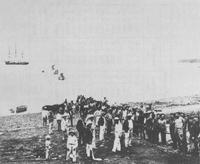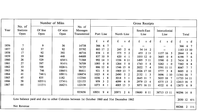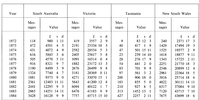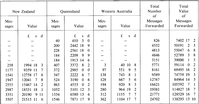


Chapter 8
I Part 1: Communications
i Before the Telegraph
ii Electrical Communication Before Federation
iii Federation to the End of the Second World War
iv Post-war and on to 1975
v 1975 ONWARDS
II Epilogue
III Part 2: Early Australian Computers And Computing
IV Acknowledgements
References
Index
Search
Help
Contact us

Electrical Communication Before Federation
Information on telegraph technology was brought to Australia by a Canadian, Samuel McGowan, who had studied under Morse. Using local timber for poles, imported galvanised wire and insulators which were improvised locally, in 1854 he constructed Australia's first telegraph line, from Melbourne to Williamstown and, employing equipment similar to that used in North America, carried out successful experiments and demonstrations. The potential of the new method of communication was recognised and within a few years a network of lines had been constructed to link the major centres in Victoria. Traffic grew rapidly and the telegraph service was soon a fundamental part, particularly of business life, of the colony. Other colonies followed suit and by 1858 Adelaide, Melbourne and Sydney were linked, while in the following year a telegraph cable was installed from Victoria to Tasmania but this failed shortly after installation. Extensive development work in cable design and manufacture was then being undertaken in Europe and America and based on this experience a second cable was successfully installed between Victoria and Tasmania in 1870.Building the telegraph network was a major engineering undertaking as, apart from the distances involved, there was then no body of theoretical knowledge concerning the transmission of signals over a line. Lord Kelvin's work later established the importance of line constants of resistance, inductance, leakage and capacitance, but for many years the telegraph network was evolved from an empirical base. Moreover, the complex nature of square waves of electricity was not understood at that time.[5] Add to this that within Australia there was no source of training in the new sciences and no supporting industry and the magnitude of the task can be comprehended.
Achievement, nevertheless, was quite remarkable. Within two decades from the construction of the first line, poles and wire stretched from the Gulf of Carpentaria right down through the goldfields and centres of population of Queensland, New South Wales and Victoria and across to Adelaide and in 1872, Todd completed the epic engineering task of building the Adelaide to Darwin route, where the Australian system connected to the world system via the Darwin to Java cable. Shortly afterwards, the section around the Great Australian Bight was constructed and Australia had a national and international service.[6]

Table 1 gives details of the growth of the Victorian telegraph network between 1856 and 1867, the numbers of messages sent and their cost. Table 2 lists international business transacted in the years 1872 to 1884.[7]



Organisations in Australian Science at Work - Victorian Telegraph Service, 1856-1867
People in Bright Sparcs - McGowan, Samuel; Todd, Sir Charles
 |
Australian Academy of Technological Sciences and Engineering |  |
© 1988 Print Edition pages 535 - 536, Online Edition 2000
Published by Australian Science and Technology Heritage Centre, using the Web Academic Resource Publisher
http://www.austehc.unimelb.edu.au/tia/529.html